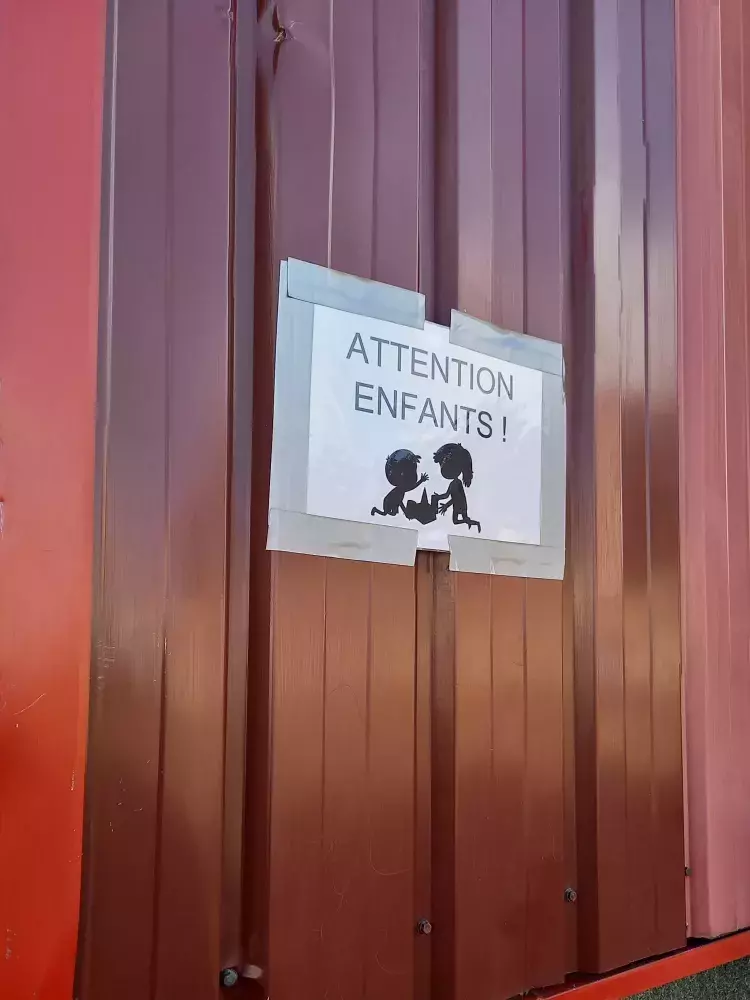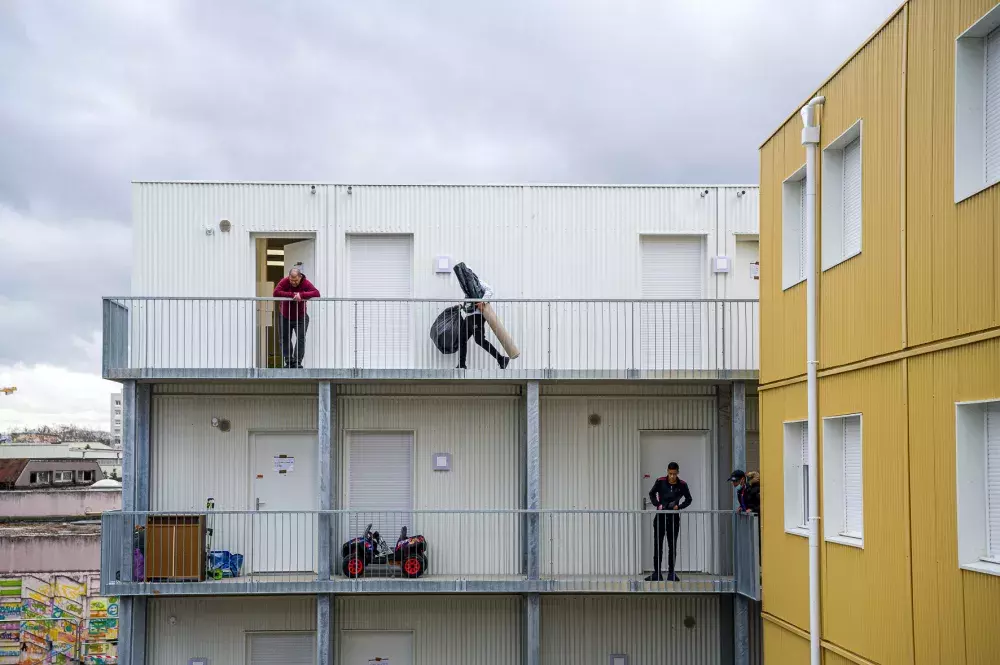Temporary Urban Planning to Address Homelessness Gains Ground in Villeurbanne, Grand Lyon

The Home Silk Road project in Villeurbanne, Grand Lyon is inter alia an experiment in temporary planning and architecture to address homelessness. With the project due to end this Autumn, this article examines how this approach is being scaled up as part of public policy to address homelessness in Villeurbanne and Grand Lyon.
A major European conference on homelessness was organised by the Metropole of Lyon in March 2022. Participants were invited to visit both Home Silk Road and LA BASE, another project using temporary architecture and planning to address homelessness in Villeurbanne. It was an occasion to take stock of how this model can contribute to the fight against homelessness in the Metropole of Lyon and other cities.
Temporary architecture can be defined as “purposely short-lived structures, exhibitions and programmes that create experimental sites for interaction and engagement”[1]. In the context of homelessness, temporary architecture mobilises land or buildings to provide housing for those that need it, as well as creating new opportunities for them to participate in society. As many cities in Europe face rising levels of homelessness and a shortage of affordable housing solutions, there is growing interest in exploring such models.
The Home Silk Road project involves the activation of a brownfield site, which since 2019 is being transformed into a new residential neighbourhood. Modular housing has been installed to temporarily accommodate homeless families during the redevelopment process. The families were previously living in a disused building on the site, repurposed into a homeless shelter (Centre d ’Hébergement d’Urgence). The modules are factory-prefabricated and wooden-framed. They have been used to create 3 buildings, over 3 floors. The units are studios with private bathrooms and kitchens. At the end of the project, the modules will be redeployed to provide temporary housing on other sites. As well as temporary housing, the project has focused on turning the site into a hub for cultural, participatory, and social economy activities.
LA BASE opened at the beginning of March 2020. 17 single women with young children (51 people in total) live here in “Tiny Houses” - 20m² mobile bungalows for up to 4 people. Each contains a small bathroom, combined kitchen and living area, and a bedroom. The project is financed by the Metropole of Lyon and an association of businesses working to address homelessness, L'Entreprise des Possibles. The land has been made available by the Metropole. Another similar project, Les Amazones, followed in 2021. Both projects reflect a new political commitment to developing temporary urbanism as part of the solution to homelessness.
The two projects have many things in common, notably:
- Residents have a 6-month renewable contract. This is the same as if they were living in a shelter or a hotel, the most common forms of accommodation provided to people facing homelessness.
- In both projects, there is an emphasis on the physical quality of the units. This is important because poor quality modular housing often means inadequate space and light, noise, poor insulation, and poor ventilation.
- Both projects mobilise temporarily, using mobile units that can be redeployed elsewhere
- Residents have a private living space with their own kitchen and bathroom, unlike in a shelter or hotel. The aim is to provide more dignified living conditions.
- The target group of both projects is people who cannot currently access permanent housing because they have an irregular residency status.
- A local NGO provides support to residents in both projects: la MAS at LA BASE and Alynea at Home Silk Road. They coordinate the site and support residents with access to rights, social inclusion, employability, parenthood etc.
- Despite the focus on quality, the housing units are small and basic. In some cases, they are too small for the needs of the family living there. Heating and cooling issues have also been highlighted.
- On both sites, there is some communal space (laundry room, common room etc.)
- Both projects involve opportunities to participate in community, cultural and social activities.
There are also some important differences between the two projects:
- LA BASE targets only single mothers with young children (under 3 years old). Responsibility for their access to shelter falls under the Metropole’s competence for child protection services. Home Silk Road targets other families in emergency shelter, falling under the competence of the French State.
- The housing units are different in appearance and structure. At Home Silk Road, the modules are arranged into a multi-story building. At LA BASE, they are stand-alone wooden bungalows. At Home Silk Road, they are mostly studios. At LA BASE, the living and sleeping spaces are separate.
- The site of LA BASE is a vacant industrial plot. The site for Home Silk Road is a construction site that is becoming a new residential and mixed-use neighbourhood. Home Silk Road partners point to a difference between temporary and transitionary architecture. The former is a short-term solution on a site that is temporarily available. It does not necessarily affect the long-term future of the site. The latter is part of the long-term development of the site. Transitionary architecture can include planning for longer-term housing solutions for homeless people. In the Home Silk Road project, approximately half of the families currently housed in the temporary modules are expected to be able to access flats via a Housing First programme once the new buildings are completed.
The Home Silk Road project has demonstrated that modular, mobile housing on land that is temporarily available can provide a more adequate response to homelessness than shelter or hotels. It has contributed to a flowering of temporary architecture projects to address homelessness, including LA BASE in Villeurbanne.
In Grand Lyon, almost 20,000 people face housing exclusion and 2,500 are homeless. The Metropole has set out its strategy for being a “hospitable city”. Temporary architecture and urban planning to meet urgent housing needs is part of this strategy. Key elements include:
- Reducing all forms of homelessness
- Direct access to housing for people whose administrative status allows it
- Access to accommodation for people with precarious administrative status (tiny villages, temporary occupation, hotels, hosting by citizens)
- Guaranteeing the dignity and safety of the most vulnerable people, improving their living conditions
- Social interventions to promote access to rights
- Actions to create links between all citizens (culture, sport, training, etc.)
A condition for the success of these projects is that the temporary housing is of adequate quality in terms of space, light, noise, ventilation, and insulation. Another is that access to services is available. A third is the availability of social support, especially with access to rights and regularisation.
These projects remain a temporary solution. Housing is offered based on 6-month renewable contracts. The modular units will not be able to stay on these sites over the long term. A big test is therefore the longer-term housing outcomes for the families that are being temporarily housed. Ideally, the residents would be able to regularise their status and access social rights to obtain regular housing. Indeed, the provision of more qualitative accommodation and social support in these projects should help achieve this goal. However, the reality of migration policy in France today makes this difficult.
Temporary architecture and planning are not alternatives to permanent affordable housing. The latter needs to be programmed in line with housing needs at a territorial level. They are rather a useful additional tool in responding to urgent housing needs, especially for people whose administrative status prevents them from accessing permanent housing. Home Silk Road has demonstrated the added value of a transitional approach, whereby longer-term housing needs of temporary residents are part of the longer-term plan for the site.
One of the emerging lessons from the project is that the effective redeployment of modules on temporary sites relies on the availability of suitable sites. This is a challenge in tense real estate markets. The fact that project partner Est Metropole Habitat, because of its size as a public housing company, has a significant volume of sites in development at any given time, is emerging as an important factor for ensuring that the Home Silk Road modules can be successfully redeployed. This also points to the importance of a coherent territorial strategy for temporary architecture/urban planning, rather than just one-off projects.
Both projects reflect the fact that for people without a recognised residency status, the way out of homelessness and into regular housing is blocked. This is a result of migration policy and is in many respects beyond the control of the projects themselves. Good quality social support can help with the regularisation process but not fundamentally change the structural barriers faced by project beneficiaries. Temporary accommodation that ensures privacy and dignity supports inclusion is a better option than staying in a hotel or traditional shelter.
Temporary architecture and planning is gaining ground as part of the solution to homelessness in Villeurbanne and Grand Lyon. Home Silk Road has provided a testing ground for this approach, which is now being replicated and scaled up locally. It is difficult to judge exactly to what extent Home Silk Road is a determinant factor in the emergence of other individual projects. However, it is clear that it has contributed to growing momentum around temporary architecture and urbanism in the local area. Similar projects are also emerging in cities across Europe, although the quality of housing and support varies enormously. Home Silk Road can provide useful learning to cities considering or launching this type of project.
About this resource
The Urban Innovative Actions (UIA) is a European Union initiative that provided funding to urban areas across Europe to test new and unproven solutions to urban challenges. The initiative had a total ERDF budget of €372 million for 2014-2020.
Similar content






